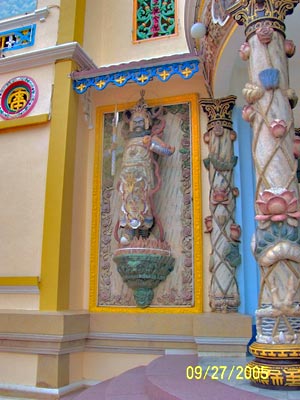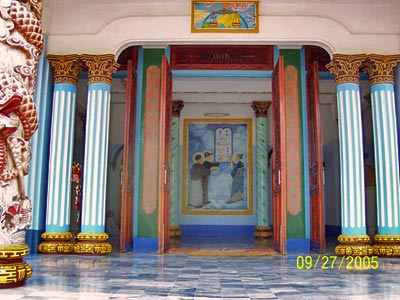Worshipping the Eye in Vietnam
Our driver has stalled the van, jumping out to ask for help from a nearby gatekeeper. In ninety degree heat, my Vietnamese companions and I gaze through the windshield at a large yellow gate that stands between us and our destination. We are outside the main compound of Cao Dai, one of Vietnam's largest indigenous faiths, and we are stuck.
Finally easing the van through a tiny gate, our driver drops us in a dusty lot. We emerge from the vehicle to a wonderland of brightly decorated buildings. A procession is passing us, consisting of white-robed women alongside men in black pajamas offset by white turbans. The men are carrying a monument resembling a dragon. To the beat of a drum, this cluster of perhaps a dozen Cao Dai worshippers proceed to the entrance of an ornate cathedral. And so, Cao Dai.

in the 1919 as an answer to Vietnam's fractious ideological strife, Cao Dai sought to blend the country's many belief systems. Counting Jesus Christ, Buddha, and Voltaire among its deities, this unique faith teaches that all religions are equal. Attracting only a marginal segment of the population, mostly in the southwestern province of Tay Ninh, the sect nonetheless established its own military during the 1960's in a bid to rule the land. Now Cao Dai's military is gone and its followers are shrinking in number. Yet its capital in Tay Ninh is as colorful as ever. Visitors are regarded with curiosity, but are not unusual: tourist flock every year to this sight they cannot find anywhere else in the world.
The compound consists of a perhaps a dozen buildings, most of which function as housing for priests and priestesses. We walk toward the most prominent structure: the cathedral. Its entrance is decorated with carved multi-colored Buddhist demons intended to frighten away evil spirits.
Worshippers are tuning traditional Vietnamese instruments in preparation for daily worship. We are stopped by a tiny priestess whose white robes and pixie-like appearance belie inner strength. She tells us that we absolutely must show respect for the faith by removing our shoes before entering.

The cathedral's inner chamber dazzles visitors with overwhelming color. Carved pink dragons slither down bright columns in a massive room topped by sky-blue ceilings. Our priestess guide grips my arm firmly, instructing me where and when to take photos. She leads me to an altar housing the center of Cao Dai, the sacred eye. Symbolic of an all-seeing higher power, a single human eye surrounded by rays of light is the emblem most associated with this enigmatic cult. Here the eye glistens on a huge blue globe that fills the entire altar. Before it are gold containers filled with incense, fruit, and flowers, offerings to this most central aspect of the faith.
Outside, the cathedral continues to amaze. A plethora of gods and goddesses adorn its walls, proving the Cao Dai pantheon to be truly diverse. Monuments of dog-like creatures painted blue, red, and yellow stand out like clowns in the midst of a serene community. We wander the compound, finding that like most Vietnamese, Cao Daists farm for a living. Adhering to a strict vegetarian diet, sect members rely upon fields of vegetation for their sustenance. Towering above the gardens are three-tiered minaret-like structures serving as monuments to the gods. Perhaps most striking is the absolute solemnity with which Cao Daists regard their religion; they live with the peace of knowing that they are doing exactly what they believe.
Our driver deftly steers us out of the compound and into a maze of streets jammed with traffic. We have left the peace of a tiny land where all faiths blend into one, and ideology becomes a lifestyle. We are back in our normal fast-paced world, away from the realm of the all-seeing eye.
